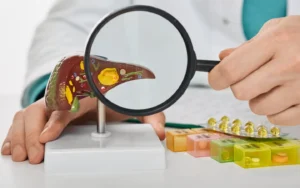What Is Liver Cancer?
Liver cancer is a condition in which liver cells grow uncontrollably, leading to the formation of tumors. The liver is a vital organ in the human body responsible for filtering the blood and converting nutrients and medications from the digestive system into chemicals needed for cellular consumption.
Additionally, the liver secretes bile and enzymes that aid in digestion and nutrient absorption. It transports its secretions to various parts of the body through bile ducts and blood vessels.
Types of Liver Cancer
Liver cancer is categorized into two groups:
- Primary liver cancer, which originates from liver tissue, with hepatocellular carcinoma being the most common type. The incidence of primary liver cancer has increased globally in recent years.
- Secondary liver cancer, also known as metastatic liver cancer, results from cancer originating in other parts of the body and spreading to the liver. Common primary tumor sites that lead to metastatic liver cancer include the colon, breast, lung, pancreas, and stomach. Cancer cells spread to the liver through the bloodstream.
Immediate attention should be given to liver diseases, including liver cancer. Despite the significance of these cancers and other conditions, patients should not be overly concerned. The goal of these articles is to provide knowledge, promote prevention, and ensure timely treatment.
Causes of Liver Cancer
The following factors increase the risk of developing liver cancer:
- Long-term exposure to hepatitis B or C
- Excessive alcohol consumption
- Liver cirrhosis is a pathological condition in which the liver is replaced with scar tissue, resulting in its inability to perform its normal functions and ultimately leading to various complications that affect the body. One of the potential complications of this condition is liver cancer. Hepatitis C and alcohol abuse are primary causes of cirrhosis, and a significant number of liver cancer patients have a history of cirrhosis.
- Obesity
- Diabetes (high blood sugar)
- Increasing age
- Exposure to certain toxins such as arsenic, aflatoxins, and steroids
- Hemochromatosis (conditions that lead to excessive iron absorption in the body)

Signs and Symptoms of Liver Cancer
A person diagnosed with liver cancer may not exhibit specific symptoms in the early days of the disease, but as the disease progresses, the following symptoms may become apparent:
- Abdominal swelling and pain
- Accumulation of fluid in the abdomen
- Nausea or vomiting
- Unexplained weight loss and loss of appetite
- Jaundice (yellowing of the skin and whites of the eyes)
- Fever
- Fatigue and weakness
- Dark-colored urine
- Presence of a lump on the right side of the abdomen
Diagnosing Liver Cancer
A physician, through examination and after conducting multiple tests, can diagnose liver cancer and determine the type of treatment. These tests include:
- Blood Tests:
Blood tests cannot directly diagnose liver cancer; however, they provide valuable insights into blood biochemistry and liver enzyme levels. Following this, the physician can identify the type of liver cancer and associated changes that have occurred in the body. Assessing blood clotting, hepatitis, and tumor characteristics during blood analysis is crucial.
- Liver Ultrasound:
A widely favored approach for identifying liver neoplasms, using a technique that simultaneously examines multiple regions of the chest and abdomen. Additionally, this radiation-free imaging method poses no risk and can be repeated as needed.
- Liver CT Scan:
- Liver Angiography:
- Liver MRI:
This is a widely favored approach for identifying liver neoplasms, using a technique that simultaneously examines multiple regions of the chest and abdomen. Additionally, this radiation-free imaging method poses no risk and can be repeated as needed.

- Liver Biopsy:
Biopsy or tissue sampling is the only definitive method for determining the type of tumor, whether it’s benign or malignant.
- Liver Laparoscopy:
During this specific medical procedure, a physician introduces a laparoscope, a thin tube containing a camera and light, into a restricted opening in the abdominal area. Afterward, the physician can visually examine the liver and obtain samples from the specified area.
Recovery and Treatment
Managing this disease is contingent on numerous factors, including the individual’s overall well-being, the malignancy grade, and the tumor’s size. Key intervention methods include surgical procedures and chemotherapy that may result in liver transplantation.
Surgical Treatment:
The preferred therapeutic approach includes two distinct methods.
One of these methods is hepatectomy, a surgical procedure that involves the removal of a portion of the liver.
The amount of tissue removed depends on the size and location of the tumor. This approach may entail the removal of a small segment or an entire lobe, known as a hemi-hepatectomy. The remaining liver tissue can regenerate and regain its normal functions. Postoperative side effects are generally short-term.
It typically takes four to six weeks for the liver to regenerate and restore its primary size and function. During this period, the patient does not need to be hospitalized.
In some medical institutions, laparoscopy is utilized as a tool to perform this specific medical procedure, involving the use of a large incision and then creating several small holes instead. This less invasive approach is associated with a reduced recovery period.
Additionally, some physicians may decide to perform tumor resection concurrently with this surgical intervention, the details of which are explained below. Furthermore, a complete hepatectomy, which entails the removal of the entire liver and subsequent transplantation, may also be performed. This course of treatment is usually reserved for cases where malignancy has not spread to other anatomical structures. Following liver transplantation, the patient is typically hospitalized for two to three weeks and is discharged only after comprehensive and thorough monitoring, ensuring the absence of any complications.

Ablation:
Ablation, as a medical procedure, involves the use of heat or ethanol injection to eliminate cancer cells. This specific method is performed with the assistance of local anesthesia to alleviate any potential discomfort. Its potential to assist individuals who are not suitable candidates for surgical methods or transplantation makes it a suitable alternative.
Radiation Therapy:
This method entails the use of powerful radiation to eradicate malignant cells.
Chemotherapy:
Chemotherapy, a type of drug therapy, is prescribed orally or intravenously to eliminate cancer cells.
Embolization and Chemoembolization:
The aforementioned techniques are used to block or reduce the blood vessels that supply nourishment to the neoplasm, preventing or reducing its proliferation.
Hepatoblastoma in Children:
In general, there is no specific or precise cause for hepatocellular carcinoma (HCC) in children. However, several factors play a role in the development of liver cancer in children, such as environmental pollution, inadequate dietary intake, medications, inappropriate treatment methods, and genetic and hereditary disorders that make them susceptible to malignant cell growth throughout their lives.
The most noticeable clinical symptoms of liver cancer in children include:
- abdominal swelling
- loss of appetite
- fatigue
- and the diagnosis of malignant cancerous masses in liver tissue.
Hepatoblastoma has been identified as the predominant form of liver cancer diagnosed in children. The cause of this disease in children can be traced back to the prenatal period. It’s worth noting that hepatoblastoma and carcinoma represent two distinct types of cancer that exclusively originate and spread inside the liver.
According to scientific research, there is a higher susceptibility to hepatoblastoma in children with hepatitis B and those who are within the age range of four and younger. It is important to mention that the prevalence of hepatoblastoma is primarily observed in boys, who fortunately tend to diagnose the disease before the age of two and subsequently experience a rapid recovery.

Initiating treatment for a child with hepatoblastoma should begin from the onset of initial symptoms, including abdominal swelling and abdominal pain, to address the need for transplantation and chemotherapy. The likelihood of treatment success using surgery and chemotherapy is over 70%, contingent upon the diagnosis of hepatoblastoma in its early stages.
Last Word
Whether you are exploring surgical options like hepatectomy or considering alternative treatments such as ablation, radiation therapy, or chemotherapy, Dr. Maadico provides clear and compassionate support.
Take the first step towards effective liver cancer management by consulting with Dr. Maadico. Understand the nuances of your condition, explore available treatment options, and receive guidance on post-operative care and lifestyle adjustments.
Don’t let liver cancer go unnoticed; empower yourself with knowledge and expert care. Consult with Dr. Maadico to navigate the path towards a healthier future.
Get a Free Consultation
Frequently Asked Questions
- How much does liver cancer treatment cost?
The cost of liver cancer treatment depends on the physician’s diagnosis, the severity of the disease, and the extent of the tumor. However, in general, the associated costs include the following:
- Costs related to diagnostic tests prescribed by the physician.
- Hospitalization costs.
- Surgical expenses.
- Chemotherapy session costs.
- Radiation therapy session costs.
- Medication expenses.
- What are the ways to prevent liver cancer?
According to researchers, the following methods can help reduce the risk of developing liver cancer:
- Exercise, a simple practice that over half of the population can engage in to avoid liver cancer.
- Excessive long-term alcohol consumption increases the likelihood of developing liver cirrhosis and consequently liver cancer. Therefore, reducing alcohol consumption significantly reduces the risk of liver cancer.
- Receiving the Hepatitis B vaccine, especially for individuals addicted to drugs who share needles or engage in risky sexual relationships.
- Preventing Hepatitis C infection through safe sexual practices.
- Maintaining a balanced and appropriate weight.
- Proper nutrition and avoiding fatty foods and preservatives that lead to liver fat accumulation.
- Controlling diabetes.

- Does genetics play a role in the development of liver cancer?
To date, it has not been definitively established, and the occurrence of this disease is associated with factors such as diabetes, fatty liver, and hepatitis.
- What is the role of nutrition in the development of liver cancer?
Proper nutrition, reducing the consumption of fatty foods and alcoholic beverages, and maintaining a proportional weight are among the factors that have a significant impact on reducing the risk of developing liver cancer.
- How long is the hospitalization period for liver cancer surgery?
The duration of hospitalization depends on the patient’s age, overall health, and the type of surgery.
- On average, the required hospitalization period for open liver surgery and partial liver resection is 5 to 7 days
- while for laparoscopic surgery and partial liver resection, it ranges from 2 to 5 days.
- In the case of liver transplantation, the patient is typically hospitalized for 2 to 3 weeks under the care of medical professionals.
- What are the post-operative care for liver cancer surgery?
- Smoking cessation.
- Abstaining from alcohol for at least 3 months because during this period, the liver is regenerating and replacing lost tissue.
- Maintaining a healthy diet plan.
- Avoiding heavy lifting, such as carrying grocery bags or lifting laundry from the washing machine.
- Refraining from activities like vacuuming and sweeping.
- Engaging in short and mild exercises like walking.


